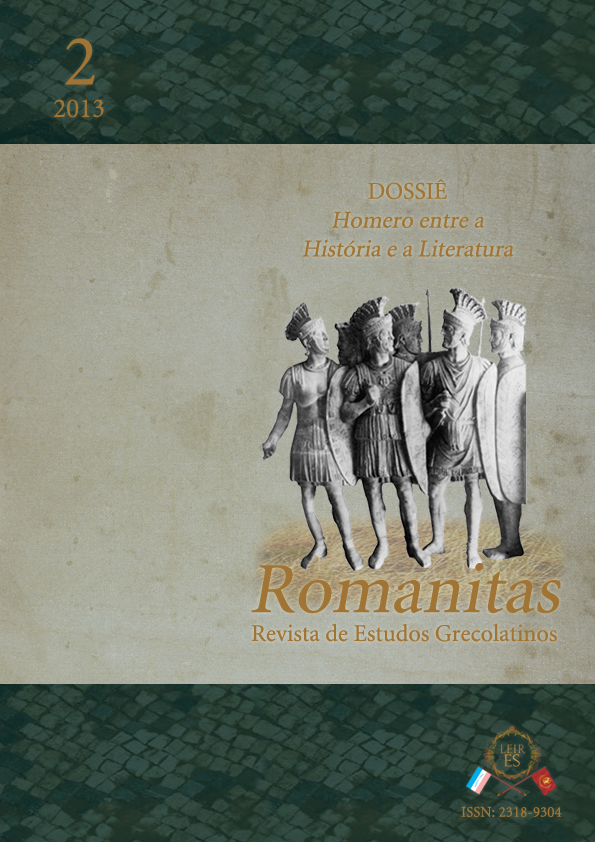The feminine protection of iliadic discourse: three interventions for the life of Hector
DOI:
https://doi.org/10.17648/rom.v0i2.7410Keywords:
Homeric poetry, Gender, Protection, AdulthoodAbstract
This article intends to reflect on a particular aspect of the notion of protection typically bound to the woman’s social action. Based on three successively passages in which three feminine characters seek to protect Hector’s life, we discuss the kind of protection that the Homeric poetry tends to associate to the woman’s world.
Downloads
References
Documentação primária impressa
AESCHYLUS. Aeschylus – v. 2 Agamemnon. Translated by Herbert Weir Smyth. London: William Heinemann, 1926.
HOMER. Homeri Opera in five volumes. Oxford: Oxford University Press, 1920.
HESIOD. The Homeric Hymns and Homerica. Works and Days. Hugh G. Evelyn-White (Ed.). London: William Heinemann Ltd., 1914.
HESIOD. The Homeric Hymns and Homerica. Theogony. Hugh G. Evelyn-White (Ed.). London: William Heinemann, 1914.
PLATO. Platonis Opera. John Burnet (Ed.). Oxford: Oxford University Press, 1903.
SOPHOCLE. Théatre Complet. Traduction de Robert Pignarre. Paris: Garnier Frères, 1964.
Obras de apoio
BACON, N. T. Hector as a poetic creation. The Classical Journal, v. 18, n. 8, p. 504 505, 1923.
BONNAFÉ, A. Poésie, nature et sacré. Tome I. Homère, Hésiode et le sentiment grec de la nature. Lyon: Maison de l'Orient et de la Méditerranée Jean Pouilloux, 1984.
BURGESS, J. Achilles’ Heel: the death of Achilles in ancient myth. Classical Antiquity, v. 14, n. 2, p. 217-244, 1995.
CERTEAU, M. A Invenção do cotidiano: artes de fazer. Petrópolis: Vozes, 1994.
COLE, S. G. Demeter in the ancient Greek city and countryside. In: ALCOCK, S. E. Placing the gods: sanctuaries and sacred space in ancient Greece. Oxford: Clarendon Press, 1994, p. 84-106.
CLARKE, M. Manhood and heroism. In: FOWLER, R. (Ed.). The Cambridge companion to Homer. Cambridge: Cambridge University Press, 2011, p. 74-90.
DELGADO, J. C. R. El desarme de la cultura: una lectura de la Ilíada. Madrid: Katz Editores, 2010.
DETIENNE, M.; VERNANT, J-P. Métis – as astúcias da inteligência. São Paulo: Odysseus, 2008.
FENIK, B. C. “Iliada X” and the “Rhesus”: The Myth. Brussels: Latomus, 1964.
FOXHALL, L.; SALMON, J. When men were men: masculinity, power and identity in Classical Antiquity. London: Routledge, 1998.
GAMBON, L. La institucion imaginaria del oîkos en la tragédia de Euripides. Bahia Blanca: Ediuns, 2009.
HERITIER, F. “Masculino-Feminino”. In: ROMANO, R (Dir.). Enciclopédia Enaudi. Lisboa: Imprensa Nacional, 1987, p. 11-26. v. 20.
LANGDON, S. Art and identity in Dark Age Greece, 1100-700 BCE. New York: Cambridge University Press, 2010.
MEZAGUER, S. La femme et la mort en Grèce Ancienne. Paris: L’Harmattan, 2012.
MOLINOS, M. T. T. Madres y nodrizas en la Antiguidad. In: GONZÁLEZ, M.; RODRÍGUEZ, A. P. Venus sin espejo: imágenes de mujeres en la Antigüedad clásica y el cristianismo primitivo. Oviedo: KRK Ediciones, 2005, p. 57-79.
MORAES, A. S. Curso de vida e construção social das idades no mundo de Homero (séc. X ao IX a.C.): uma análise sobre a formação dos habitus etários na Ilíada e Odisseia. 2013. Tese (Doutorado em História) – Programa de Pós-graduação em História da Universidade Federal Fluminense. Niterói, 2013.
MURNAGHAN, S. Disguise and Recognition in the Odyssey. Princeton: The Princeton University Press, 1992.
NAGY, G. Homeric Questions. Texas: The University of Texas Press, 1996.
OTTO, W. F. Os deuses da Grécia. São Paulo: Odysseus, 2005.
PAPAIKONOMOU, I-D. Enfance et identité sexuée dans les cités grecques. In: GUSI, F.; MURIEL, S.; OLÀRIA, C. (Org.). Nasciturus, infans, puerulus vobis mater terra: la muerte en la infancia. España: Deputacion de Castello, 2008, p. 683-710.
SCOTT, J. A. Paris and Hector in tradition and in Homer. Classical Philology, v. 8, n. 2, p. 160-171, 1913.
VERNANT, J-P. Mito e pensamento entre os gregos: estudos de psicologia histórica. Rio de Janeiro: Paz & Terra, 1990.
VERNANT, J-P. Mort grecque mort à deux faces. In: ______. L’individu, la mort, l’amour: soi-même et l’autre en Grèce Ancienne. Paris: Gallimard, 1989, p. 81-89.
Downloads
Published
How to Cite
Issue
Section
License
Copyright (c) 2014 Romanitas - Revista de Estudos Grecolatinos

This work is licensed under a Creative Commons Attribution-NonCommercial-NoDerivatives 4.0 International License.
a. The authors retain copyright and grant the journal the right to first publication.
b. The authors are authorized to assume additional contracts separately, for non-exclusive distribution of the version of the work published in this journal (e.g., publishing in institutional repository or as a book chapter), with acknowledgment of authorship and initial publication in this journal.
c. Authors are allowed and encouraged to publish and distribute their work online (e.g. in institutional repositories or on their personal page) after the first publication by the journal, with due credit.
d. The journal's texts are licensed under a CC BY 4.0 Deed Attribution 4.0 International Licence (CC BY).




























